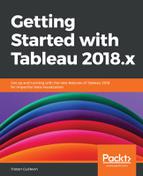All the field options are available with a right-click on any field. Here's the list of all the options:

There are some straightforward options, so let's see a short description for those that aren't trivial:
- Show filter: Only appears if you have something in the Worksheet. We'll see this option in Chapter 7, Design Insightful Visualizations - Part 2.
- Hide: Hides the field but doesn't suppress it. It's a great way to clean your Data Source if there are many fields that you won't use. The option is only available if the field is never used. You can show the hidden field by clicking on the arrow next to Dimension and selecting Show Hidden Fields:

- Delete: Suppresses custom fields (Bins, Sets, Parameters, Calculated Fields, and others) from the Data Source.
- Aliases...: Allows you to rename the values of a Dimension. It opens a new window with the list of the values. For example, you can add Aliases to Ship Mode:

- Create: Opens a sub-menu where you can create new Fields. Groups, Bins, and Set are explained in the Groups, Sets, and Bins section of this chapter, Calculated Fields are detailed in Chapter 10, An Introduction to Calculations, and Parameters are the focus of Chapter 11, Analytics and Parameters.
- Convert to Discrete or Convert to Continuous: Only applies to Numbers and allows you to switch from a Continuous field to a Discrete field or vice versa.
- Convert to Dimension or Convert to Measure: Allows you to switch from a Measure to a Dimension or vice versa. If you try to convert anything other than a Number from a Dimension to a Measure, an aggregation is automatically applied. For example, if you Convert the Customer ID field to a Measure, the Count Distinct aggregation is automatically applied:
- Geographical role: The geographical role is available on a text dimension and allows you to specify a geographical role (Country, State, Region, or Other) if Tableau didn't recognize it automatically.
- Group by: Opens a sub-menu where you can select Folder or Data Source Table. It affects the way Tableau organizes the Dimension and Measure. With Data Source Table, fields are linked to their tables. With Folder, all the fields are mixed, and you can create folders to group them. The following screenshot is an example of what your Data Source could look like with folders:

- Hierarchy is the topic of the next section.
Again, you don't have to remember everything. Keep in mind that if you want to change or customize something related to a field, you'll surely find it with a simple right-click.
The last option we have to see in detail is default properties.
